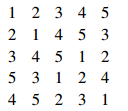

تاريخ الرياضيات

الاعداد و نظريتها

تاريخ التحليل

تار يخ الجبر

الهندسة و التبلوجي


الرياضيات في الحضارات المختلفة

العربية

اليونانية

البابلية

الصينية

المايا

المصرية

الهندية


الرياضيات المتقطعة

المنطق

اسس الرياضيات

فلسفة الرياضيات

مواضيع عامة في المنطق


الجبر

الجبر الخطي

الجبر المجرد

الجبر البولياني

مواضيع عامة في الجبر

الضبابية

نظرية المجموعات

نظرية الزمر

نظرية الحلقات والحقول

نظرية الاعداد

نظرية الفئات

حساب المتجهات

المتتاليات-المتسلسلات

المصفوفات و نظريتها

المثلثات


الهندسة

الهندسة المستوية

الهندسة غير المستوية

مواضيع عامة في الهندسة

التفاضل و التكامل


المعادلات التفاضلية و التكاملية

معادلات تفاضلية

معادلات تكاملية

مواضيع عامة في المعادلات


التحليل

التحليل العددي

التحليل العقدي

التحليل الدالي

مواضيع عامة في التحليل

التحليل الحقيقي

التبلوجيا

نظرية الالعاب

الاحتمالات و الاحصاء

نظرية التحكم

بحوث العمليات

نظرية الكم

الشفرات

الرياضيات التطبيقية

نظريات ومبرهنات


علماء الرياضيات

500AD

500-1499

1000to1499

1500to1599

1600to1649

1650to1699

1700to1749

1750to1779

1780to1799

1800to1819

1820to1829

1830to1839

1840to1849

1850to1859

1860to1864

1865to1869

1870to1874

1875to1879

1880to1884

1885to1889

1890to1894

1895to1899

1900to1904

1905to1909

1910to1914

1915to1919

1920to1924

1925to1929

1930to1939

1940to the present

علماء الرياضيات

الرياضيات في العلوم الاخرى

بحوث و اطاريح جامعية

هل تعلم

طرائق التدريس

الرياضيات العامة

نظرية البيان
Latin Squares
المؤلف:
W.D. Wallis
المصدر:
Mathematics in the Real World
الجزء والصفحة:
74-75
15-2-2016
2285
The combination of several experimental variables can make experiments prohibitively large and expensive. However, combinatorics, the mathematical study of arrangements, can sometimes provide clever arrangements of treatments that help hold down the size and cost of experiments. We will illustrate this by a comparison of motor oils.
Some makers of motor oil claim that using their product improves gasoline mileage in cars. Suppose you wish to test this claim by comparing the effect of four different oils on gas mileage. However, because the car model and the driver’s habits greatly influence the mileage obtained, the effect of an oil may vary from car to car and from driver to driver. To obtain results of general interest, you must compare the oils in several different cars and with several different drivers. If you choose 4 car models and 4 drivers, there are 16 car–driver combinations. The type of car and driving habits are so influential that you must consider each of these 16 combinations as a separate experimental unit. If each of the 4 oils is used in each unit, 4×16, or 64, test drives are needed.
However, there is a way to test the effects of cars, drivers, and oils that requires only 16 test drives. Call the oils A,B,C, and D and assign one oil to each of the 16 car–driver combinations in one of the two arrangements shown in the figure below.
The different rows represent the different cars and the different columns represent the different drivers. Study these arrangements: each oil appears 4 times, exactly once in each row (for each car) and also exactly once in each column (for each driver). This setup can, in fact, show how each oil performs with each car and with each driver.

An arrangement like that in the motor oil example is called a Latin square experiment, and the figure is called a 4 × 4 Latin square; it arranges 4 kinds of objects (the oils) in a 4 × 4 matrix. The “Latin” property is that each label appears exactly once in each row and in each column. There are several different 4×4 Latin squares. In a Latin square experiment, one first chooses a Latin square of the needed size at random from all the possible squares. Then the four drivers are assigned at random to the columns, the four cars at random to the rows, and the four motor oils at random to the labels A,B,C,D. After the test drives are completed, the results are handed over to a statistician, who has ways to test whether the results obtained might have been obtained by chance, or show a real difference in the effect of the oils.
In general an n×n Latin square is a square array with n rows, n columns, whose entries are chosen from n symbols. Each symbol occurs exactly once in each row and exactly once in each column.
Here is a 5×5 example:

You have probably seen Latin squares in the form of sudoku puzzles. A standard sudoku array is a 9 × 9 Latin square partitioned into nine 3 × 3 subsquares—rows 1,2,3 and columns 1,2,3, rows 1,2,3 and columns 4,5,6, rows 1,2,3 and columns 7,8,9, rows 4,5,6 and columns 1,2,3, and so on, up to rows 7,8,9 and columns 7,8,9— with the property that every subsquare contains every symbol exactly once. In the puzzle, certain entries are omitted, and you have to find them; usually the array is designed so that there is exactly one answer.
A sudoku array need not be 9×9; puzzle books often include (easier) examples of size 6×6 with 2×3 subsquares or (harder) 16×16 examples with 4×4 subsquares.
The right-hand 4 × 4 square shown above is a (very easy) sudoku square, a 4 × 4 square with 2×2 subsquares.